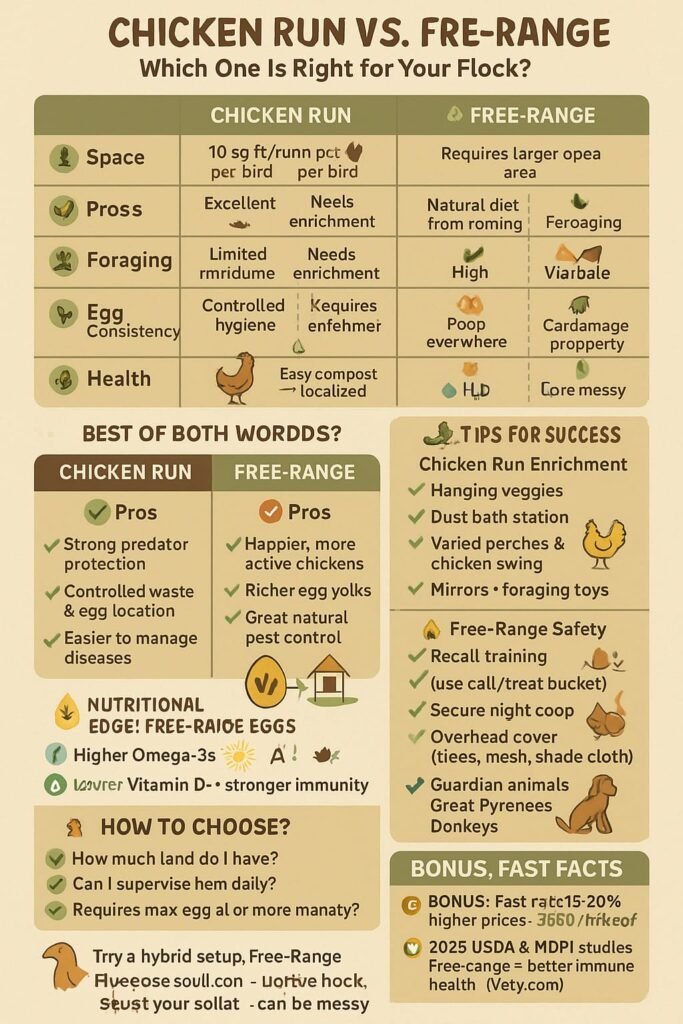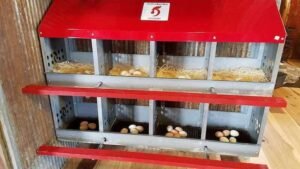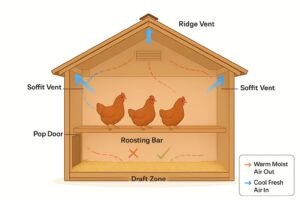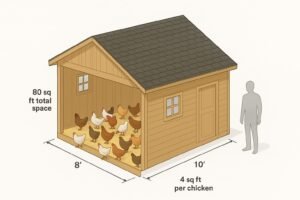Getting into backyard chickens means a big decision: chicken run or free-range? Or maybe both? There’s no single “right” answer. What’s best for your flock truly depends on your space, lifestyle, and local wildlife. This guide helps you figure out what’s truly best for you.
I remember picturing chickens happily scratching everywhere. Then reality hit: my petunias became a chicken buffet, and a hawk showed up. That’s when I learned this choice is about balancing chicken well-being with practicality and safety.
✅ Quick Take: Chicken Run vs Free-Range ✅
- Best for Safety & Control: Chicken Run
- Best for Natural Diet & Activity: Free-Range
- Best Compromise: Rotational Grazing or Chicken Tractor
→ Choose based on space, time, predators, and your goals.
Understanding Chicken Housing: What Are Your Options?
For outdoor time, chickens have two main backyard chicken enclosure options: a chicken run or free-ranging. Both need a secure chicken coop for roosting, laying, and overnight safety. The difference is how much freedom your birds get during the day. If you’re just starting out, understanding the basics of coop size is crucial – you can learn more in our guide: How Big Should a Chicken Coop Be?
A chicken run is an enclosed outdoor area, usually attached to the coop. Think of it as their dedicated outdoor playpen, keeping them safe and contained. Free-ranging means chickens roam unrestricted, typically in your yard or pasture, foraging for food. Each has its perks and pitfalls. And if you’re a first-timer, avoid common pitfalls by checking out: Mistakes Every First-Time Chicken Keeper Makes.
Chicken Run Explained: Controlled Environment, Controlled Benefits
A chicken run is a fenced outdoor space for your flock. It can be simple or a fortress. The main thing: it keeps chickens contained while giving them fresh air and sun.
When I started, I thought a small run was fine for my three hens. I quickly learned ample space and enrichment are vital. A cramped run means bored, stressed chickens and a muddy mess. A well-designed run, though, can be a great solution for many.
The Advantages of a Chicken Run: Safety and Simplicity
Let’s talk about the pros of a chicken run. Chicken runs offer solid predator protection. Hawks, foxes, raccoons – they’re all looking for an easy meal. A securely built run with hardware cloth (not just chicken wire!) and a roof can literally save lives. This controlled space also keeps chickens from wandering, preventing them from ending up in a neighbor’s garden or a busy road. This is key to a predator-proof chicken coop setup.
Runs simplify waste management. Droppings are contained, making cleanup and composting easier. Runs can also help with disease control by limiting exposure to wild birds or contaminated areas. Plus, you’ll always find your eggs in the coop, not hidden somewhere!
The Disadvantages of a Chicken Run: Limitations and Management
Now for the cons of a chicken run. Runs offer safety, but they have space limitations. Chickens are natural foragers. A small run can lead to boredom and behaviors like feather-picking. You’ll also see soil degradation as chickens strip vegetation, turning the area dusty or muddy.
Limited foraging means chickens in a run need more supplemental feeding, increasing feed costs compared to free-ranging. Overcrowding or lack of enrichment (stumps, branches, hanging treats) leads to unhappy hens.
Free-Range Chickens: The Natural Way, The Open Way
Free-ranging means chickens roam unrestricted outdoors, foraging for food. This can be unsupervised, or supervised (letting them out for a few hours while you’re home). It’s the classic image of happy chickens.
Free-Range Regulations & Definitions
It’s important to know that “free-range” isn’t always as simple as it sounds, especially when buying eggs or meat.
- USDA Definition: In the United States, the USDA defines “free-range” poultry as having had outdoor access for more than 51% of their lives. However, this definition doesn’t specify the size or quality of that outdoor area, and certification is optional. So, a “free-range” chicken might just have a small concrete pad to access [thesprucepets.com, en.wikipedia.org, backyardchickens.com].
- EU Standards: In the European Union, free-range poultry standards are generally stricter. For laying hens, the maximum migratory density is ≤4 m2/poultry, and daytime open-air access is required [en.wikipedia.org]. This means more space and guaranteed outdoor time.
The Advantages of Free-Ranging: Health and Happiness
Free-ranging lets chickens express natural foraging behaviors. They scratch for bugs, worms, and seeds, getting a varied, natural diet. This often means healthier birds from exercise and diverse nutrition. Many keepers swear free-range chickens produce higher quality eggs, with richer, darker yolks from their varied diet. (And no, you don’t need a rooster for those eggs! Find out why here: Do I Need a Rooster to Get Eggs?).
Beyond health, free-ranging can significantly cut feed costs as they find much of their own food. Plus, they’re fantastic pest control, happily gobbling up ticks, slugs, and garden nuisances. It’s a win-win!
The Disadvantages of Free-Ranging: Risks and Realities
The biggest free-range risk is predators. Hawks, foxes, raccoons, even neighborhood dogs can quickly decimate a flock. My first free-ranging attempt ended with a lost hen and ruined vegetable patch – a harsh lesson on supervision and secure night housing. Is free-ranging safe for backyard chickens? The answer heavily depends on your local predator pressure and your ability to supervise.
Chickens are curious. Free-ranging means they might wander off your property, into a neighbor’s yard, or the road. They can also cause significant crop damage in gardens.
You’ll also deal with chicken droppings scattered everywhere. This can be an aesthetic issue or a hygiene concern, especially if you have kids or pets. They’re also more susceptible to disease exposure from wild birds or contaminated areas. As noted earlier, a systematic review from March 2025 on backyard farms in low-income countries highlights that while infectious diseases are a major cause of mortality, predation is also a significant non-infectious threat to backyard flocks.
⚠️ Warning: Know the Risks ⚠️
But there’s one thing most people overlook: what’s in your soil. Free-ranging chickens can be exposed to hidden environmental dangers, like:
- PFAS Bioaccumulation: Per- and polyfluoroalkyl substances (PFAS), often called “forever chemicals,” can accumulate in soil from various sources. Chickens foraging in contaminated soil can ingest these chemicals, leading to bioaccumulation in their bodies and eggs.
- Lead Exposure: Especially in urban or older suburban environments, soil can contain lead from old paint, industrial activity, or leaded gasoline residue. Chickens can absorb lead through foraging, which can then transfer to their eggs, posing a health risk to both the chickens and those consuming their eggs.
Always be aware of your soil’s history and consider testing it if you have concerns about contaminants before allowing extensive free-ranging.

Chicken Run vs. Free-Range: A Head-to-Head Comparison for Decision Making
Choosing between a run and free-ranging isn’t just about what sounds good; it’s about what works for your situation. Let’s compare them on key factors.
| Feature | Chicken Run | Free-Range |
|---|---|---|
| Space Needs | Minimum 10 sq ft/chicken in run, 4 sq ft/chicken in coop. Defined, managed. | Theoretically unlimited; requires enough property to roam without issues. |
| Predator Protection | Superior if built securely (hardware cloth, roof). | High risk; often requires constant supervision or guardian animals. |
| Flock Health | Easier disease/parasite control in confined space; overcrowding can stress. | Less parasite buildup; varied diet boosts immunity. More exposure to wild bird diseases. Research from December 2024 suggests free-range chickens have lower stress and more robust immune systems. |
| Egg Quality | Consistent production; yolk color depends on feed. | Perceived richer, darker yolks from varied diet. Production might be less consistent. May 2025 USDA data shows cage-free eggs command a higher market price. |
| Cost & Labor | Higher initial setup; lower ongoing feed if vegetated run. Regular cleaning. | Lower initial setup; fluctuating feed costs based on forage. More supervision/egg hunting labor. Vety.com’s 2025 cost estimates show annual feed for a small flock (3-5 chickens) can range from $300 to $600. |
| Environmental Impact | Concentrated manure for composting; limited yard impact. | Excellent natural pest control; manure spread as fertilizer (can be messy). |
Space Requirements and Management: How Much Room Do They Really Need?
- Chicken Run: Minimum 10 square feet per chicken in the run, plus 4 square feet per chicken inside the coop. It’s a defined space you manage, possibly rotating runs or adding fresh bedding. A June 2025 study in Poultry (MDPI) reinforces that adequate stocking density is crucial for welfare and can impact production, even in commercial settings. This means ample space is just as important for backyard birds. If you’re wondering how much space do chickens need to be happy, remember that more room generally leads to healthier, less stressed birds. If you’re wondering how many chickens your family needs, check out: How Many Chickens Do You Need for a Family of 4?.
- Free-Range: Theoretically unlimited space! Realistically, you need enough property for them to roam without causing issues. Management involves training them to return to the coop at night and potentially using temporary fencing to protect areas. For context, commercial free-range standards, like those from the RSPCA (July 2025), suggest at least 8 square meters per 1,000 birds for range access. This shows the significant outdoor space true free-ranging requires, even for smaller flocks.
Predator Protection: Keeping Your Flock Safe
- Chicken Run: Superior protection if built correctly. Hardware cloth (1/2 inch or 1/4 inch) buried into the ground (an “L-footer”) stops digging predators. A secure roof protects from aerial threats. This is crucial for how to predator-proof a chicken run.
- Free-Range: High risk. Constant supervision is often needed. Chickens are vulnerable to hawks, foxes, and other predators, as discussed earlier.
Flock Health and Hygiene: Preventing Pests and Disease
- Chicken Run: Easier to control parasites and diseases in a confined space. Regular cleaning and bedding changes are crucial. Overcrowding, however, can lead to stress and faster disease spread. This is where good backyard flock biosecurity practices come into play, regardless of your setup. Regularly cleaning coops and runs, quarantining new birds, and keeping wild birds away from feed and water sources are vital steps to prevent illness.
- Free-Range: Less confined, so less parasite buildup in one spot. Varied foraging diet can boost immunity. Research from December 2024 suggests free-range chickens, with outdoor access, experience lower stress and more robust immune systems, potentially reducing the need for supplements and medications [MDPI, Dec 2024]. Still, they’re more exposed to diseases from wild birds or contaminated areas outside your control.
Egg Quality and Production: Does the Method Matter?
- Chicken Run: Consistent egg production due to controlled feed and environment. Eggs are easy to find in the coop. Yolk color depends entirely on feed.
- Free-Range: Often perceived to have richer, darker yolks from a varied diet of greens and bugs. Production might be slightly less consistent if they’re expending more energy foraging, and eggs can be harder to find (or get dirty). This perceived quality translates to market value: in May 2025, USDA data shows cage-free eggs had an ex-farm benchmark price of 353 cents per dozen, compared to 304 cents per dozen for conventional caged eggs [USDA May 2025 Egg Market Report]. Consumers are clearly willing to pay more for these perceived benefits.
🥚 Nutritional Insight: The Free-Range Egg Advantage 🥚
While all eggs are nutritious, free-range eggs often boast a superior nutritional profile compared to those from conventionally raised hens. This is largely attributed to their varied diet from foraging. Studies and observations suggest free-range eggs may contain:
- More Omega-3 Fatty Acids: From consuming greens and insects.
- Higher Vitamin A: Often indicated by a deeper orange yolk.
- Increased Vitamin D: Due to more exposure to sunlight.
- Elevated Vitamin E: Another benefit of a diverse, natural diet [farmstandapp.com, en.wikipedia.org, dakotastorage.com].
While variations exist, giving your hens access to varied forage can genuinely boost the goodness in your breakfast.
Cost and Labor: What’s the Investment?
- Chicken Run: Higher initial setup cost for sturdy materials (hardware cloth, wood, roofing). Lower ongoing feed costs if they have a large, vegetated run. Labor involves regular cleaning and bedding changes.
- Free-Range: Lower initial setup if you already have a secure coop and don’t need extensive fencing. However, ongoing feed costs fluctuate based on how much natural forage your property offers. For a small flock (3-5 chickens), annual feed costs can range from $300 to $600 [Vety.com 2025 Feed Cost Study]. While free-ranging helps, feed remains a significant expense. Labor involves more supervision and egg hunting.
Environmental Impact and Pest Control: Chickens as Eco-Warriors
- Chicken Run: Manure is concentrated, easy to collect and compost. Limited impact on the rest of your yard.
- Free-Range: Excellent natural pest control – they eat ticks, slugs, and insects. Manure is spread throughout the yard, naturally fertilizing it (though it can be messy on patios!).
Which Option is Best for YOU? Tailoring Your Choice to Your Situation
The best choice between a chicken run and free-ranging truly depends on your space, local rules, predator threats, and how much time you have. There’s no single “better” option; it’s about finding the right fit for your unique circumstances.
Assessing Your Space, Lifestyle, and Goals
Before you decide, be realistic about your situation:
- Property Size: Enough land for chickens to roam without bothering neighbors or getting lost?
- Local Regulations: Any city or HOA rules on free-ranging or enclosures? Always check! Understanding your local chicken laws by state is absolutely critical before you even get started: Chicken Laws by State.
- Predator Pressure: Are hawks, foxes, or other predators common nearby? Huge factor.
- Time Availability: Can you supervise your flock for hours daily if free-ranging? Or do you need a more hands-off approach?
- Egg Production Goals: Aiming for maximum eggs (favors a controlled run) or more natural foraging?
Hybrid Approaches: Getting the Best of Both Worlds
Many owners successfully combine methods – supervised free-range time or rotating runs. This is often the sweet spot!
- Supervised Free-Ranging: Let chickens out for a few hours when you’re home to watch them. They forage and exercise, minimizing predator risk.
- Rotational Grazing/Chicken Tractors: This approach lets you give chickens fresh forage while keeping them contained. A “chicken tractor” (also known as a mobile chicken coop or movable chicken run) is a bottomless, movable coop and run. You simply move it to a new patch of grass daily or weekly. This allows chickens to fertilize and clear small areas, then move on, giving the land time to recover. It’s a fantastic way to mimic free-ranging benefits without the full risks of open roaming. If you’re weighing a chicken tractor vs free range, remember the tractor offers a blend of safety and fresh forage, a great compromise for many. [en.wikipedia.org, apnews.com, bhg.com].
Making the Most of Your Chosen Method: Practical Tips for Success
No matter your choice, you can always make your chickens’ lives better and your setup more efficient. These tips come from real-world chicken keeping, learning from experience. If you’re just getting started, don’t miss our guide on What’s the Best Age to Start Raising Chickens?
Optimizing Your Chicken Run
If you’re going with a run, make it great!
- Provide Enrichment: Bored chickens are unhappy chickens. Add stumps, branches for perching, hanging cabbage, or even old tires to explore. These chicken enrichment ideas are crucial for preventing boredom.
- Dust Bath Area: Chickens need to dust bathe to stay clean and control parasites. Offer a dry, dusty spot, maybe with sand or wood ash.
- Shade and Shelter: Ensure plenty of shade, especially in summer. A solid roof over part of the run protects from sun and rain.
- Cleanliness is Key: Regularly remove droppings and refresh bedding. This prevents odor, flies, and disease.
✅ Enrichment Checklist for Happy Chickens ✅
Want to keep your flock entertained and healthy, especially in a run? Here’s a quick list of boredom busters for chickens:
- Dust Bath Station: A designated spot with fine dirt, sand, or wood ash for essential cleaning.
- Varied Perches: Stumps, branches, or even old ladders at different heights.
- Hanging Treats: Cabbage, corn on the cob, or suet balls to peck at.
- Foraging Opportunities: Scatter scratch grains or dried mealworms in bedding to encourage natural scratching.
- Chicken Swing/Toys: Believe it or not, chickens can enjoy a simple swing!
- Mirrors: Some chickens find their reflection amusing.
- Remote Camera: Not for enrichment, but a great way to observe their behavior and ensure safety when you’re not around.
Enhancing Your Free-Range Experience
If free-ranging, do it safely and effectively:
- Secure Overnight Coop: Non-negotiable. Free-range chickens still need a secure coop at night, safe from nocturnal predators.
- Training for Recall: Teach chickens to come back to the coop (a specific call or treat bucket works wonders). Invaluable when you need to round them up fast.
- Protect Vulnerable Areas: Use temporary fencing or netting for gardens or flowerbeds you want chicken-free.
- Water and Food Stations: Even free-ranging chickens need fresh water and supplemental feed, especially if natural forage is scarce.
Advanced Predator Protection Strategies
Beyond basic fencing and constant supervision, some advanced strategies can significantly boost your flock’s safety, especially for free-ranging birds:
- Guardian Animals: Dogs, particularly breeds like Great Pyrenees, Anatolian Shepherds, or Livestock Guardian Dogs (LGDs), are bred to protect livestock. Donkeys can also be effective guardians against smaller predators like foxes and coyotes. These animals form a bond with the flock and actively deter threats [thesprucepets.com, nestera.us, homesandgardens.com].
- Remote Cameras: For peace of mind when you can’t be physically present, setting up remote cameras with motion detection can be a game-changer. Many systems offer alerts to your phone, allowing you to check on your flock and identify potential threats in real-time. This technology helps you understand predator patterns and react quickly [thesprucepets.com, nestera.us, homesandgardens.com].
Common Questions About Chicken Housing (FAQs)
How much space does a chicken need in a run?
A good rule of thumb: at least 10 square feet per chicken in the outdoor run. More space is always better for boredom prevention and hygiene.
Do free-range chickens lay more eggs?
Not necessarily more, but their eggs may have richer, darker yolks from a more varied diet of greens and insects. Laying consistency often depends more on breed, age, and overall health.
Is it cruel to keep chickens in a run?
No, not if the run is adequately sized, clean, and provides plenty of enrichment. A well-designed run offers crucial safety and protection from predators and harsh weather.
Can chickens free-range in a city?
Depends entirely on local city ordinances and your property size. Many cities have strict rules on free-ranging due to concerns about droppings, noise, and potential neighbor issues. Always check local regulations first.
How do I protect my free-range chickens from hawks?
Overhead cover (trees, shade cloths), a rooster, or a guardian animal can help. Supervised free-ranging, where you’re present while they roam, is often the most effective method.
Ready to Dive Deeper into Chicken Keeping?
Choosing the right housing is just one step on your amazing backyard chicken journey! Whether you’re planning your first coop or looking to refine your flock management, we’ve got more insights to help you succeed.
Explore our other helpful guides:
- How Big Should a Chicken Coop Be? Get the exact measurements for a happy flock. [https://chickenstarter.com/how-big-should-a-chicken-coop-be/]
- Mistakes Every First-Time Chicken Keeper Makes: Learn from our experiences so you don’t have to! [https://chickenstarter.com/mistakes-every-first-time-chicken-keeper-makes/]
- Do I Need a Rooster to Get Eggs? Clear up common misconceptions about egg laying. [https://chickenstarter.com/do-i-need-a-rooster-to-get-eggs/]
- Chicken Laws by State: Understand local regulations before you start. [https://chickenstarter.com/chicken-laws-by-state/]
- What’s the Best Age to Start Raising Chickens? Find out when to welcome your new feathered friends. [https://chickenstarter.com/whats-the-best-age-to-start-raising-chickens/]
- How Many Chickens Do You Need for a Family of 4? Plan your flock size perfectly. [https://chickenstarter.com/how-many-chickens-do-you-need-for-a-family-of-4/]
Happy chicken keeping!

Oladepo Babatunde is the founder of ChickenStarter.com. He is a backyard chicken keeper and educator who specializes in helping beginners raise healthy flocks, particularly in warm climates. His expertise comes from years of hands-on experience building coops, treating common chicken ailments, and solving flock management issues. His own happy hens are a testament to his methods, laying 25-30 eggs weekly.



